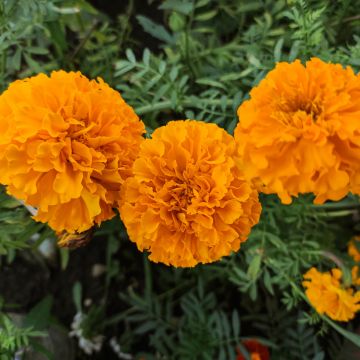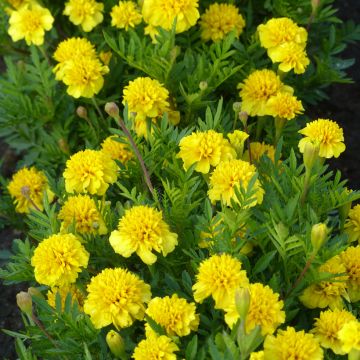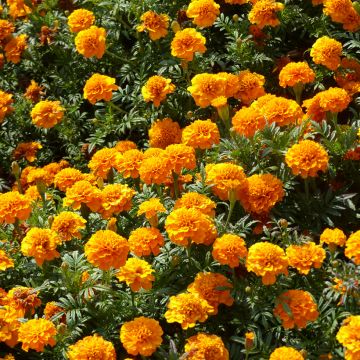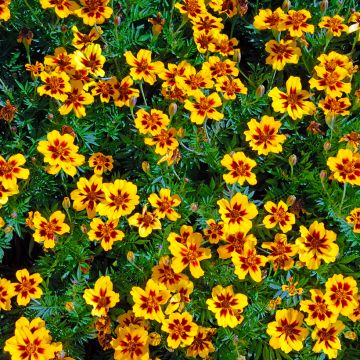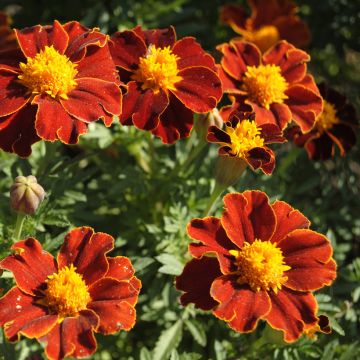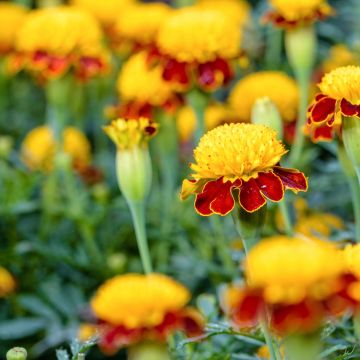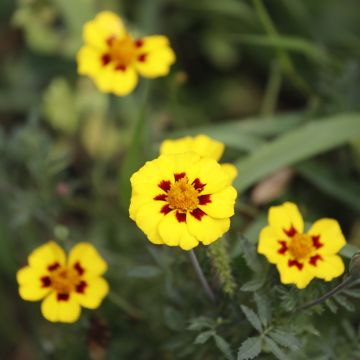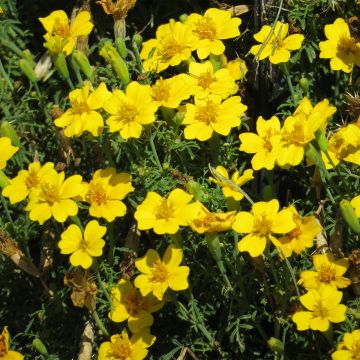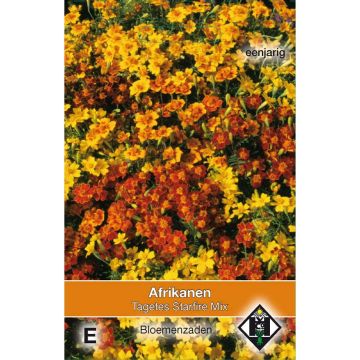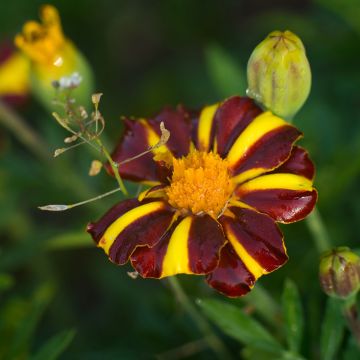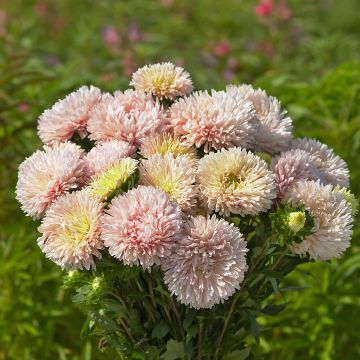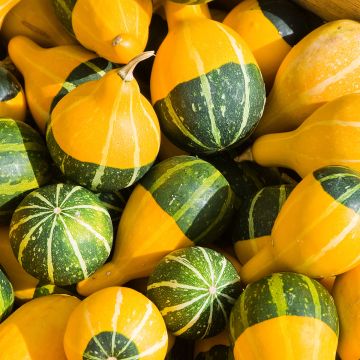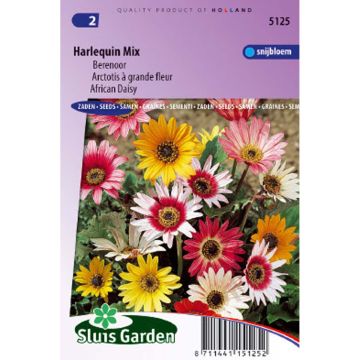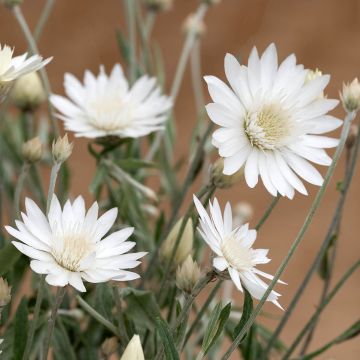

Tagetes x patula Sunburst F1 mixed
Tagetes x patula Sunburst F1 mixed
Tagetes x patula Sunburst F1 mixed
French marigold
Sown in pots and indoors, no seeds germinated. Complete disappointment.
Lili, 01/04/2019
Special offer!
Receive a €20 voucher for any order over €90 (excluding delivery costs, credit notes, and plastic-free options)!
1- Add your favorite plants to your cart.
2- Once you have reached €90, confirm your order (you can even choose the delivery date!).
3- As soon as your order is shipped, you will receive an email containing your voucher code, valid for 3 months (90 days).
Your voucher is unique and can only be used once, for any order with a minimum value of €20, excluding delivery costs.
Can be combined with other current offers, non-divisible and non-refundable.
Why not try an alternative variety in stock?
View all →This plant carries a 6 months recovery warranty
More information
We guarantee the quality of our plants for a full growing cycle, and will replace at our expense any plant that fails to recover under normal climatic and planting conditions.
Would this plant suit my garden?
Set up your Plantfit profile →
Description
This flamboyant mixture of Sunburst F1 French Marigold, also brings together four varieties of Tagetes patula whose variegated flowers are almost as large as Indian roses. They display, depending on the plants, solid or two-tone flowers, golden yellow, or yellow striped with copper, or even orange/copper with single or semi-double corollas. These bushy and compact annuals bloom from June to October in sunny borders and planters. They are easy to sow and succeed in all gardens, from the simplest to the most elaborate. To be grown in well-drained soil, in full sun or partial shade.
Tagetes patula is an herbaceous annual plant of the Asteraceae family, native to tropical regions of the Americas, from Mexico to Bolivia. Each of the plants in the Sunburst F1 mix quickly forms a small, branching clump which is 35 cm (14in) in all directions, covered with dark green, highly cut foliage, strongly aromatic, whose smell may be unpleasant. The flowering extends from June to October, if faded flowers are regularly removed. The 'Sunburst F1' selection offers magnificent single or semi-double heads, whose ligules (the flowers located at the periphery of the head, highly developed) host gold, orange, and copper in all their forms: some are solid, golden yellow, others widely or finely striped with copper on a yellow or orange background, and the latter are a pure orange. The centre of the heads displays a more or less orange-yellow colour, bicoloured in some. These plants easily self-seed in the garden, but not always faithfully to the parent variety.
Marigolds are star plants in summer flower beds. They are sometimes criticised for their garish colours and their prim habit, but they are so cheerful, easy to grow, and floriferous that it would be a shame not to enjoy them in borders and planters. They can be planted in small patches amidst the grey foliage of artemisias and stachys, or in greenery, by combining them with tansies, Kochia Childsii, or small grasses that will temper their flamboyant colours. Marigold is also an edible flower that can be enjoyed in salads, soups, or desserts. Some believe that its flavor resembles that of passion fruits.
The scent of marigold foliage, and the substances secreted by their roots, repel certain insects harmful to crops, which is why these plants are often planted among the vegetables in the vegetable garden.
Flowering
Foliage
Plant habit
Botanical data
Tagetes
x patula
Sunburst F1 mixed
Asteraceae
French marigold
Cultivar or hybrid
Other Tagetes seeds
View all →Planting and care
Sowing:
Sow from February to April.
Sow on the surface of a special seed compost, which is moist and well-drained. Cover the seeds with a very thin layer of vermiculite or compost. Place the sowings in a mini greenhouse or enclose them in a transparent plastic bag at a constant temperature of 20 to 25° until germination, which usually takes 7 to 21 days. Do not deprive the sowings of light, as this promotes germination.
When the young plants are large enough to handle, transplant them into a tray or 8 cm (3in) pots. Acclimatise them to cooler conditions for 10 to 15 days before planting them outside at a spacing of 15 - 20 cm (6 - 8in) and as soon as frost is no longer a concern.
Growth:
These fast-growing plants thrive in sunny and warm locations. Plant them in fertile, well-drained, and light soil. Avoid excessive watering during summer, as it promotes the development of fungal diseases and root rot. Regularly remove faded flowers to prolong flowering. Protect the plants from slugs and snails, which are fond of them.
Sowing period
Intended location
Planting & care advice
-
, onOrder confirmed
Reply from on Promesse de fleurs
Similar products
Haven't found what you were looking for?
Hardiness is the lowest winter temperature a plant can endure without suffering serious damage or even dying. However, hardiness is affected by location (a sheltered area, such as a patio), protection (winter cover) and soil type (hardiness is improved by well-drained soil).

Photo Sharing Terms & Conditions
In order to encourage gardeners to interact and share their experiences, Promesse de fleurs offers various media enabling content to be uploaded onto its Site - in particular via the ‘Photo sharing’ module.
The User agrees to refrain from:
- Posting any content that is illegal, prejudicial, insulting, racist, inciteful to hatred, revisionist, contrary to public decency, that infringes on privacy or on the privacy rights of third parties, in particular the publicity rights of persons and goods, intellectual property rights, or the right to privacy.
- Submitting content on behalf of a third party;
- Impersonate the identity of a third party and/or publish any personal information about a third party;
In general, the User undertakes to refrain from any unethical behaviour.
All Content (in particular text, comments, files, images, photos, videos, creative works, etc.), which may be subject to property or intellectual property rights, image or other private rights, shall remain the property of the User, subject to the limited rights granted by the terms of the licence granted by Promesse de fleurs as stated below. Users are at liberty to publish or not to publish such Content on the Site, notably via the ‘Photo Sharing’ facility, and accept that this Content shall be made public and freely accessible, notably on the Internet.
Users further acknowledge, undertake to have ,and guarantee that they hold all necessary rights and permissions to publish such material on the Site, in particular with regard to the legislation in force pertaining to any privacy, property, intellectual property, image, or contractual rights, or rights of any other nature. By publishing such Content on the Site, Users acknowledge accepting full liability as publishers of the Content within the meaning of the law, and grant Promesse de fleurs, free of charge, an inclusive, worldwide licence for the said Content for the entire duration of its publication, including all reproduction, representation, up/downloading, displaying, performing, transmission, and storage rights.
Users also grant permission for their name to be linked to the Content and accept that this link may not always be made available.
By engaging in posting material, Users consent to their Content becoming automatically accessible on the Internet, in particular on other sites and/or blogs and/or web pages of the Promesse de fleurs site, including in particular social pages and the Promesse de fleurs catalogue.
Users may secure the removal of entrusted content free of charge by issuing a simple request via our contact form.
The flowering period indicated on our website applies to countries and regions located in USDA zone 8 (France, the United Kingdom, Ireland, the Netherlands, etc.)
It will vary according to where you live:
- In zones 9 to 10 (Italy, Spain, Greece, etc.), flowering will occur about 2 to 4 weeks earlier.
- In zones 6 to 7 (Germany, Poland, Slovenia, and lower mountainous regions), flowering will be delayed by 2 to 3 weeks.
- In zone 5 (Central Europe, Scandinavia), blooming will be delayed by 3 to 5 weeks.
In temperate climates, pruning of spring-flowering shrubs (forsythia, spireas, etc.) should be done just after flowering.
Pruning of summer-flowering shrubs (Indian Lilac, Perovskia, etc.) can be done in winter or spring.
In cold regions as well as with frost-sensitive plants, avoid pruning too early when severe frosts may still occur.
The planting period indicated on our website applies to countries and regions located in USDA zone 8 (France, United Kingdom, Ireland, Netherlands).
It will vary according to where you live:
- In Mediterranean zones (Marseille, Madrid, Milan, etc.), autumn and winter are the best planting periods.
- In continental zones (Strasbourg, Munich, Vienna, etc.), delay planting by 2 to 3 weeks in spring and bring it forward by 2 to 4 weeks in autumn.
- In mountainous regions (the Alps, Pyrenees, Carpathians, etc.), it is best to plant in late spring (May-June) or late summer (August-September).
The harvesting period indicated on our website applies to countries and regions in USDA zone 8 (France, England, Ireland, the Netherlands).
In colder areas (Scandinavia, Poland, Austria...) fruit and vegetable harvests are likely to be delayed by 3-4 weeks.
In warmer areas (Italy, Spain, Greece, etc.), harvesting will probably take place earlier, depending on weather conditions.
The sowing periods indicated on our website apply to countries and regions within USDA Zone 8 (France, UK, Ireland, Netherlands).
In colder areas (Scandinavia, Poland, Austria...), delay any outdoor sowing by 3-4 weeks, or sow under glass.
In warmer climes (Italy, Spain, Greece, etc.), bring outdoor sowing forward by a few weeks.






























